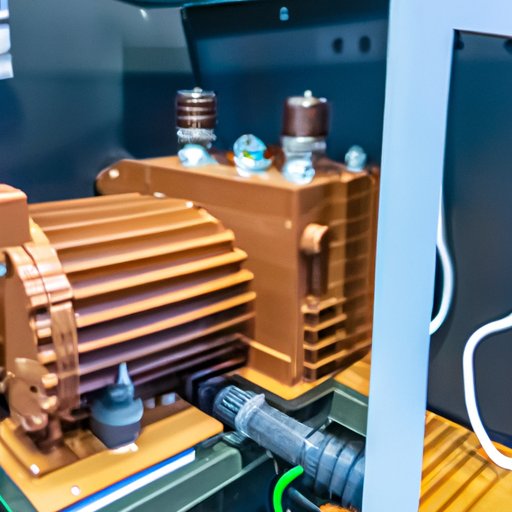I. Introduction
Electricity is an essential aspect of our daily lives. It powers everything from our homes to industrial machinery. However, not all electricity is created equal. There are different types of electricity, including single-phase and three-phase electricity. In this article, we’ll take a closer look at three-phase electricity. Understanding three-phase power is crucial, especially for those working in industrial settings.
II. Beginner’s Guide to Understanding 3-Phase Electricity
Three-phase power is a type of electrical power that utilizes three alternating currents that mutually differ in phase angles by 120 degrees.
Three-phase power has three main components, which include the following:
- Three voltage sources that are mutually identical and in phase (i.e., 120 degrees apart)
- Three phases, which are separate current waveforms that are each 120 degrees apart
- A lack of a neutral wire compared to a single-phase system
Compared to single-phase power systems, three-phase power systems have higher power and can transmit more power. They are also more efficient and reliable, making them the preferred choice for industrial applications.
III. Exploring the Mechanics of Three-Phase Power Distribution
Three-phase power is generated using an alternator or generator that produces three separate but equally spaced voltages. These voltage sources are then sent through a transformer to increase the voltage to appropriate levels that can be used for transmission.
In a three-phase power system, three phases are used to distribute power, and the phases are identified by their relative angular position. Each phase has a sine wave that starts at zero and increases to a peak, followed by a decrease to zero, and then a dip to its negative peak, before returning to zero to start a new cycle.
The voltage and frequency of three-phase power vary depending on the country or region. In the United States, the voltage is typically 240 volts, while in Europe, the voltage is usually 400 volts. The frequency is usually 60 Hertz in the United States and 50 Hertz in Europe and other parts of the world.
IV. Breaking Down the Basics of 3-Phase Motors
Three-phase motors are used extensively within industrial environments due to their high energy efficiency, low vibration and maintenance requirements, and their ability to deliver high torque levels. There are two primary types of 3-phase motors: induction motors and synchronous motors.
Induction motors work by inducing electrical currents within the rotor using the alternating magnetic field generated by the stator. Synchronous motors, on the other hand, work by synchronizing the rotating field of the stator and the rotor. They are typically used in applications where precise speed control is necessary, such as in heavy machinery or robotics applications.
Three-phase motors typically consist of a stator, rotor, and winding. The stator is the stationary component and consists of a set of coils or windings. The rotor is the rotating component of the motor and can be made from several different materials, including copper, aluminum, and steel.
V. Why 3-Phase Power is Essential for Heavy Industrial Applications
Three-phase power is crucial for heavy industrial applications that require high power levels and high torque levels. Single-phase power is simply not capable of producing sufficient power for these types of applications.
Three-phase power is used for a variety of industrial applications, including the following:
- Compressors and pumps
- Large cranes and excavators
- Industrial machinery such as grinders, saws, and lathes
- Conveyor systems
- Industrial fans and blowers
Three-phase power is also essential for improving industrial productivity and efficiency. It enables machines and equipment to run more smoothly and efficiently, reducing downtime and increasing product output.
VI. The Advantages and Disadvantages of 3-Phase Power Systems
While three-phase power systems offer several advantages over single-phase power systems, they also have some drawbacks that need to be considered.
Advantages of 3-phase power systems include the following:
- Higher power capacity and transmission
- Efficiency and reliability
- Cost-effectiveness
- Lower voltage drop compared to single-phase power
- High torque levels for industrial machinery
Disadvantages of 3-phase power systems include the following:
- More complex to install compared to single-phase power
- Higher installation costs
- More complex to repair and maintain
- Requires specialized equipment and knowledge
Overall, three-phase power systems are the preferred choice for industrial applications due to their many advantages and higher power capacity, despite some of the disadvantages associated with them.
VII. Conclusion
Three-phase power is an essential aspect of modern-day electricity, and understanding how it works is crucial, especially for those working in industrial settings. In this article, we’ve explored the fundamentals of three-phase power, its mechanics, components, and types of motors. We’ve also looked at why three-phase power is essential for industrial applications, its advantages and disadvantages, and how it impacts industrial productivity and efficiency.
It’s essential to understand that three-phase power is a complex and specialized field that requires specialized knowledge and equipment. If you’re working with three-phase power, it’s highly recommended that you seek out the services of a certified electrician or technician.
Overall, three-phase power is an essential technology that has revolutionized the industrial sector, and it’s here to stay.
(Note: Is this article not meeting your expectations? Do you have knowledge or insights to share? Unlock new opportunities and expand your reach by joining our authors team. Click Registration to join us and share your expertise with our readers.)
